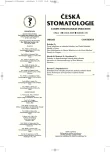Sonic Techniques of Preparation of Hard Dental Tissue
Authors:
T. Byrtus; J. Stejskalová
Authors‘ workplace:
Klinika zubního lékařství LF UP a FN, Olomouc
Published in:
Česká stomatologie / Praktické zubní lékařství, ročník 109, 2009, 1, s. 14-17
Overview
The aim of this project was to compare two different preparation techniques of hard dental tissue:
the oscillating technique by SONICflex and the classic rotary technique. We want to discover if the different preparation technique has influence on quality of marginal adaptation and microleakage of composite class II fillings. The cavities were prepared by Sonicflex in group I and by classic rotary technique completed by margin trimmer in group II. Grain size of used preparation tools was the same in both cases. All the cavities were filled by composite material and thermocycled. The tooth was cut twice in mesiodistal direction. The penetration of pigment along the margin of fillings was observed on gingival and occlusal surface. According to the results there is no significant difference in the pigment penetration. These two different preparation techniques of hard dental tissue do not have influence on the quality of marginal adaptation and microleakage of composite class II fillings.
Key words:
sonic preparation - marginal adaptation - thermocycling
Sources
1. Dostálová, T., Jelínková, H., Němec, M., Koranda, P., Miyagi, M., Shi, Y., Matsuura, Y.: Srovnání preparačního účinku laserového záření s ultrazvukovou mikropreparací a klasickou zubní vrtačkou. Prakt. zub. Lék., roč. 53, 2005, č. 4, s. 73-76.
2. Dostálová, T., Jelínková, H., Němec, M., Koranda, P., Miyagi, M., Iwai, K., Shi, Y., Matsuura, Y.: Selektivní preparace tvrdých zubních tkání ve spojení s kompozitními výplňovými materiály. Prakt. zub. Lék., roč. 54, 2006, č. 3, s. 48-53.
3. KaVo: Materiály firmy, www. kavo.com.
4. Mount, G. J.: Minimálně invazivní stomatologie, preparace kavity. Quintessenz, roč. 14, 2005, č. 6, s. 7-11.
5. Mount, G. J.: An atlas of glass-ionomer cements, A clinician´s guide. Second edition, Martin Dunitz, 1994, 150 s.
6. Neumeye, S., Gernet, W.: Minimal-invasive preparationstechnik. ZWR, roč. 110, 2001, č. 3, s. 130-133.
7. Papa, J., Cain, Ch., Nesseč, H. H.: Účinnost tunelové preparace při odstraňování kazu. Quintessenz, roč. 3, 1994, č. 6, s. 62-66.
8. Roubalíková, L.: Příspěvek k ultrazvukové preparaci tvrdých zubních tkání. Prakt. zub. Lék., roč. 53, 2005, č. 6, s. 133-137.
9. Roubalíková, L.: Alternativní preparační techniky při ošetření zubního kazu. Prakt. zub. Lék., roč. 54, 2006, č. 4, s. 63-69.
10. Stejskalová, J.: Konzervační zubní lékařství. Galén, 2003, 235 s.
11. Vambera, M., Gojišová, E., Bradna, P.: Ověření funkčnosti adhezivních systémů V. a VI. generace pomocí metody termocyklingu. Čes. Stomat., roč. 107, 2007, č. 2, s. 36-38.
12. Wicht, M. J., Haak, R., Fritéz, U. B., Noack, M. J.: Primary preparation of class II cavities with oscillating systems. Am. J. Dent., 15, 2002, 1, s. 21-25.
Labels
Maxillofacial surgery Orthodontics Dental medicineArticle was published in
Czech Dental Journal

2009 Issue 1
Most read in this issue
- Disc Plication as an Operation Method of Temporomandibular Joint Disc Dislocation
- Dental Transplantation
- Advances in Pharmacotherapy of Oral Mucosa Diseases
- Sonic Techniques of Preparation of Hard Dental Tissue
